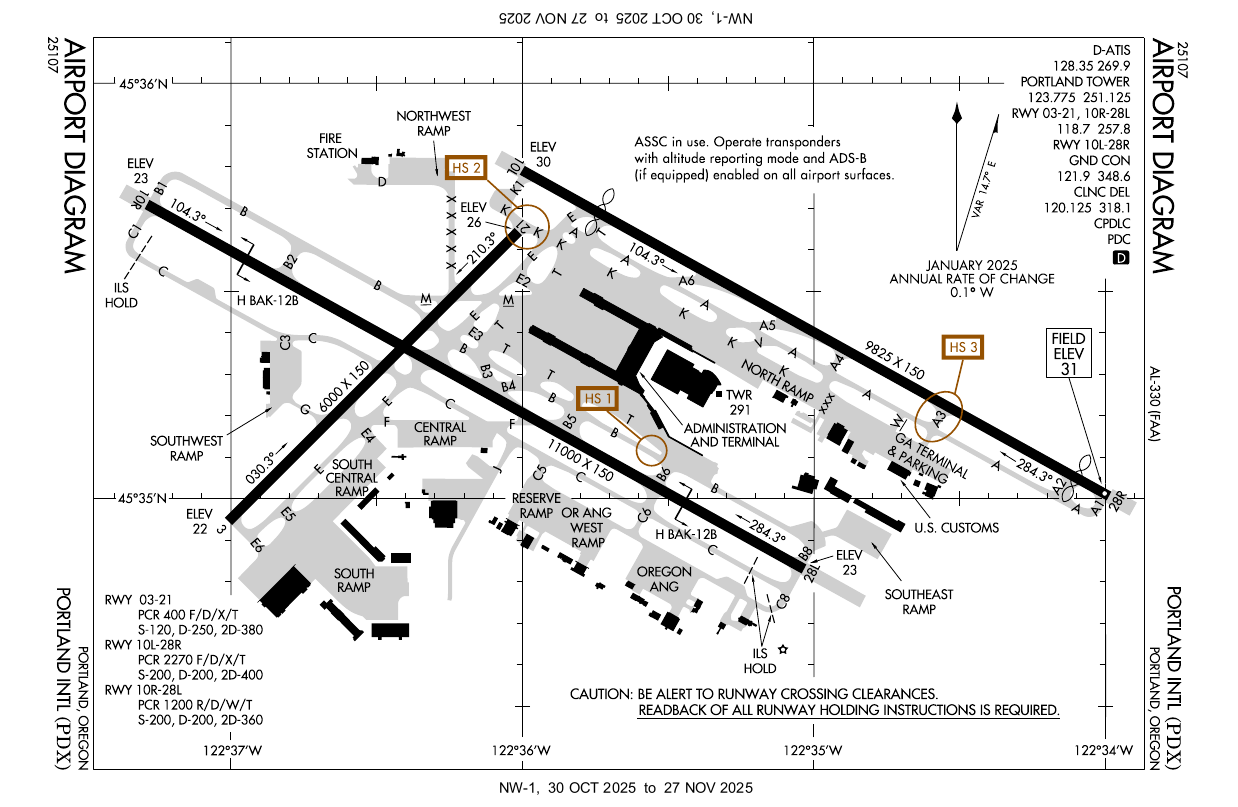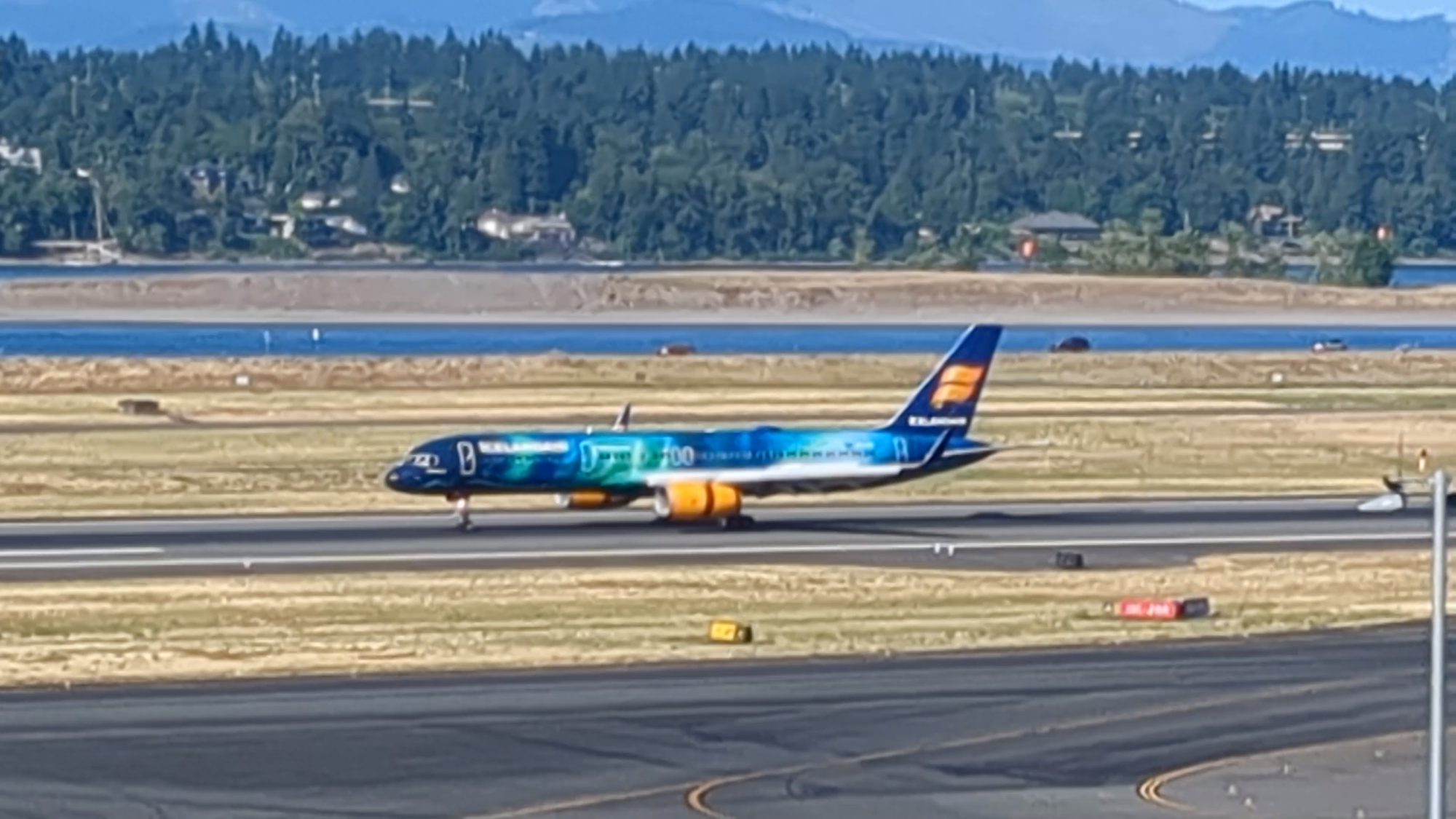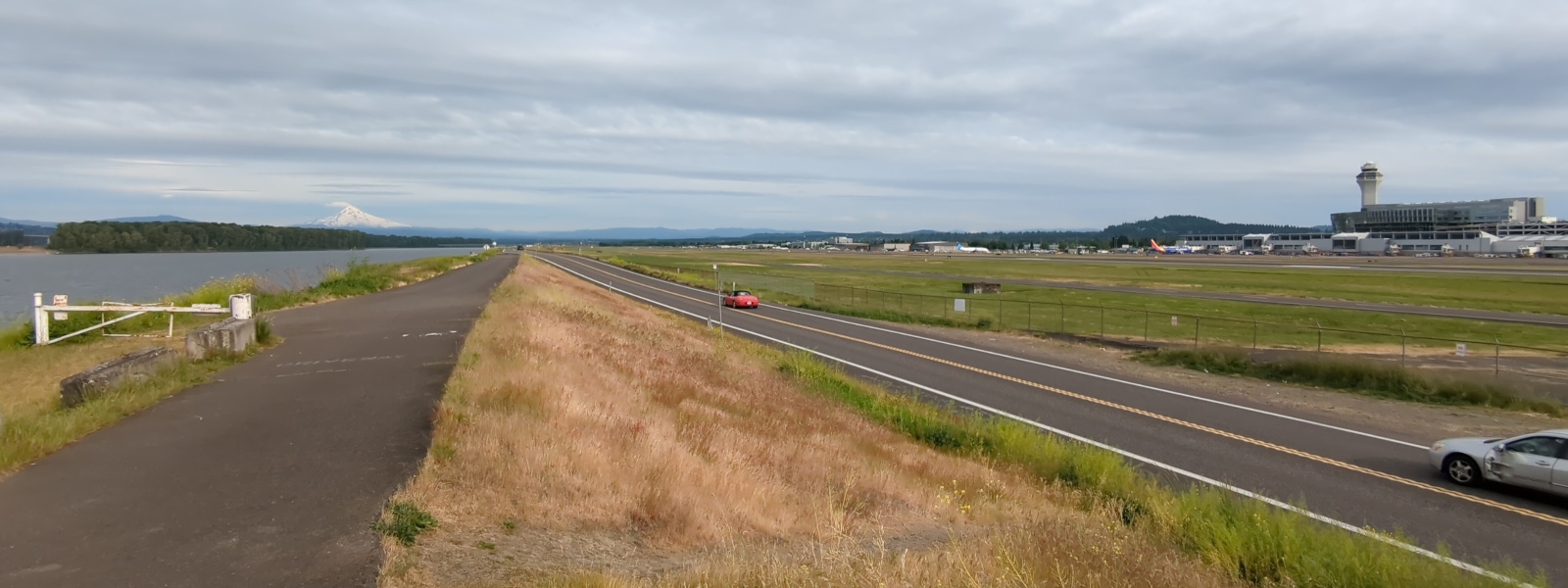by Ian Kluft
Contents
[As of November 2025, this page is a work in progress.]
Portland International Airport (PDX) has some varied interests for the aviation geek, or "avgeek". Being located in the Pacific Northwest (PNW) invites comparison to Seattle-Tacoma International Airport (SEA). Seattle is the headquarters hub of Alaska Airlines and its regional subsidiary Horizon. But Portland is also a secondary hub for Alaska and Horizon.
Seattle has far more international routes than Portland. Portland has enough to be interesting.
But PDX is also a mixed-use civilian/military airport with the Portland Air National Guard Base on the south side of the airfield. None of the Seattle-area airports is mixed-use.
Another interesting aspect of Portland for aviation geeks is that it has a Boeing paint hangar. Of course, Seattle dominates that aspect because Boeing Commercial Airplanes has two major factories there: widebody jets at Everett's Paine Field (PAE) and narrowbody jets at Renton Municipal Airport (RNT). Both those airports have paint hangars. But they aren't enough to keep up with current plane production. So some planes get flown out unpainted, with a green vinyl protective coating, to get painted at either Boeing Field (BFI) in Seattle or Portland PDX. There is no Boeing paint hangar at Seattle-Tacoma SEA. So this adds to the interesting mix for planespotting in Portland.
I've found that bicycling has advantages for planespotting at PDX Airport. Airports of course are busy places with limited parking. Some good spots at PDX are only easily accessible by bicycle. I'll share my experiences here on getting to the airport and where the viewing spots are.
Though pedestrians can access all the points too, if you take transit or find a place to park. It's just a lot slower.
Airport diagram

Safety and Security
First, some safety tips. Some are in the "prepare for the worst" category, unlikely but better to have thought about ahead of time.
- Bring hearing protection and be ready to use it. Jets can be loud enough to cause incremental hearing loss. Anywhere around the south-side runway 10R/28L, there's a possibility that Oregon Air National Guard F-15s will take off. But any jet that goes around will also go to full power. Those are the loudest normal circumstances.
- Don't fly drones near the airport. Drones are a collision hazard for airplanes and helicopters. Portland International Airport has Class C airspace out to 5 miles away. Air Traffic Control Tower permission is required to fly drones at or near the airport. See the FAA's Unmanned Aircraft Systems (UAS) info page.
- Don't loiter in places lined up with the runways. Even though aircraft accidents are extremely rare, those are the places they would be most likely. Stay on the side of statistics and don't hang around for extended periods there. Those are considered clear areas for safety reasons - if anything happens, nobody should be there.
- If you see an aircraft accident, the control tower probably knows about it. Though if it occurred off-airport or you have reason to doubt the tower was able to see it, call 911 to report it. Photos or video should be made available to the NTSB for any investigation.
Then, moving on to airport security topics...
Planespotters have excellent access at PDX. We should not take that for granted. Let's encourage each other to work together to make sure we don't lose our privileges. At all airports, planespotters need to try to be an ally of the airport's security. If not, we could see new restrictions on our access. So it's important to be well behaved and help set a good example for others.
For example, don't touch airport perimeter security fences. Assume that doing so will at least catch attention, and may be considered a security incident.
When planespotting in the airport parking structures, assume you're in view of cameras at all times. Whether being watched live or on footage reviewed later, make it obvious you are there to see airplanes. Allow some room from parked vehicles as best you can. Don't show interest in them, except for your own if you drove there.
If approached by the Portland Airport Police (part of the Port of Portland) or other law enforcement, be cooperative and friendly. If asked, tell them what you're doing. Comply with any instructions they give you, keeping in mind they may have info they can't disclose at the time. As public safety and emergency responders, we all need what they do. All of us need to sustain a community relationship that planespotters are their allies.
If you see a security incident or suspicious activity, call either the Portland Airport Police or call 911.
Getting to PDX
Planespotters have options to get to PDX by car, transit or bicycle. Some locations are only really accessible by bicycle. I'll lump scooters in with bicycles since they can usually use the same routes. Rental bikes and scooters have geofenced boundaries which may not access the whole area.
Driving to PDX, use either NE 82nd Ave / State Route 217 or Airport Way and follow signs to short term parking at the terminal.
If you don't want to pay for parking or mess with traffic at the terminal, an alternative is to park at a TriMet transit center and take the MAX Red Line light rail to the airport. The closest free parking lots are at Gateway/99th Ave Transit Center and Parkrose/Sumner Transit Center. If you don't have a Portland-area Hop Card for riding transit, you can tap a chip-equipped credit card at the station before boarding. If you want to minimize costs, note the "valid until" time when tagging in (2 hours later) and be sure to board a return train before then so it will be on the same fare. Otherwise a second TriMet fare in a day will become a day pass.
For cyclists, Portland Airport can be reached from most directions, some more or less direct than others. it's best to stick to bike paths and roads with bike lanes. Avoid or use extreme caution on roads which have no bike facilities.
| Bicycle and Pedestrian Access to PDX | ||
|---|---|---|
| From | Route | Cyclist access |
| MAX light rail | Red Line | excellent 🟢 |
| East Portland | NE 82nd Ave | avoid ❌ - use I-205 path |
| Outer East Portland to Gresham | I-205 path | excellent 🟢 |
| Hollywood district | NE 33rd Ave to Marine Drive Path | caution for traffic 🟡 |
| North Portland | Marine Drive and Marine Drive Path | caution for traffic 🟡 |
| Fairview to Troutdale | Marine Drive and Marine Drive Path | caution for traffic 🟡 |
Planespotting places at PDX

photo by Ian Kluft

photo by Ian Kluft
Planespotting areas at PDX vary in accessibility, some only accessible by bicycle. In the parking structures, in case of rain you can find cover one floor lower.
| Location | Views | Accessibility |
|---|---|---|
| parking structure: 4th or 5th floor long-term, south side | Runway 28L/10R | car, transit, bicycle |
| parking structure: 7th floor short-term, north side | Runway 28R/10L | car, transit, bicycle |
| cell phone waiting overflow lot | Runway 28R/10L | car, bicycle |
| Marine Drive multi-use path, Columbia River levee | Runway 28L/10R | car, bicycle |
| Marine Drive multi-use path at 33rd Ave | Runway 28R/10L | bicycle |
Which runway to choose
Airplanes take off and land into the wind. Check the NWS forecast for PDX to get an idea which runways will be in use and select your viewing location.
The official airport conditions are transmitted on the Automated Terminal Information System (ATIS), which is 128.35MHz at PDX. If you have a scanner, you can listen directly. Online, digital ATIS (D-ATIS) is available at various sites that display the FAA data feed, such as
Portland's main runways are numbered 28L/10R and 28R/10L. The numbers are the compass directions with the last digit removed, so approximately 280 degrees when landing and taking off westbound, or 100 degrees when eastbound. Since there are two parallel runways, they have a right (R) and left (L) suffix.
Here are some terms and abbreviations to watch for on the D-ATIS.
- CLSD
- stands for closed. You may see it with runways or taxiways. Runways in particular are what you're looking for so you don't get in position at a closed runway.
- SIMUL
- stands for simultaneous approaches. It indicates the parallel runways are both open.
- OTS
- stands for out of service. It indicates some equipment is not operating. When paired with a runway's ILS (instrument landing system) it means some flights may go for the other runway, if available. This is less significant than it used to be since most aircraft (particularly all airlines) at PDX can use GPS approaches when radio navigation is out.
You can anticipate planes will be landing and taking off into the wind. Use the direction the wind is reported or forecast to come from as the expected runway direction. When winds are coming from 280 degrees, roughly from the west, it lines up with Runways 28L and 28R. Likewise winds from the east line up with Runways 10L and 10R. Wind can come from any direction and doesn't necessarily line up with runways. So pilots and air traffic controllers use the closest direction. Crosswind landings are routine as long as they're within the capabilities of the crew and aircraft. When winds are calm, PDX uses Runways 28L and 28R.
There is a shorter crosswind runway 3/21 which is very rarely (almost never) used because it conflicts with the main runways 10L/28R and 10R/28L. Runway 3 is restricted to arrivals only, up to the first 3000ft before the intersection with 10R/28L. Runway 21 is treated as closed. In case of an emergency, the tower can waive those restrictions. It is usable for such scenarios.
- 28L/10R is south of the terminal, near the Portland Air National Guard Base
- 28R/10L is north of the terminal, near the Columbia River
When both runways are open, planes usually request (but don't necessarily always get) the runway closest to their arrival gate or desination on the airfield.
- Alaska, Hawaiian, Horizon and American (Terminals B and C) are usually on Runway 28L/10R.
- Southwest, Delta, United and international arrivals (Terminals D and E) are usually on 28R/10L.
- International departures and heavy aircraft (767, A330 and larger) prefer 28R/10L because it's the longest runway. Longer takeoff allows a higher takeoff weight with higher total of fuel, passengers and freight.
- Oregon Air National Guard F-15s prefer 28L/10R, next to the Oregon ANG Base. However visiting military aircraft may use 28R/10L if refueling at the FBOs at the north ramp.
- Cargo aircraft prefer 28L/10R for the shortest taxi to the central and south central ramp.
- New Boeing airplanes from the factories or from storage: incoming unpainted and outgoing newly-painted planes prefer 28L/10R for proximity to the Boeing Portland Paint Hangar at the south ramp.
(writing in progress - more coming)